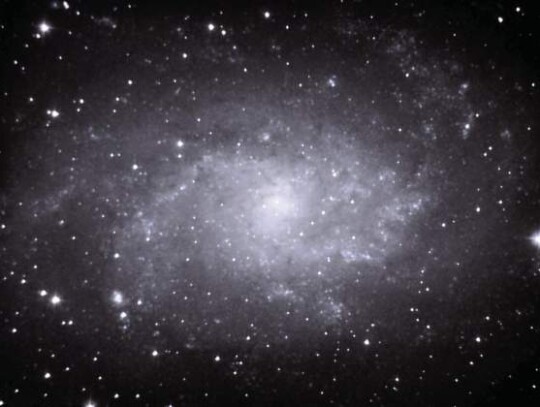NIGHT SKIES
Attached is an image run of M33, the Triangulum galaxy that I took from my backyard on Oct 21, 2022, a two-hour exposure. It’s 2.73 million light years from our galaxy, just slightly further than the Andromeda galaxy at 2.54 million light years.
The Milky way and those two galaxies form a trio of spirals in our “local group”. Just how far is that? I occasionally get questions like the following: Could we travel to the Andromeda galaxy in 100 years? The answer may surprise you. That answer is yes traveling continuously at 1g (Earth gravity).
There are technicalities which I’ll explain in a minute. First let me give you some idea of how far just one light year is. You’re familiar with the two Voyager spacecraft launched in opposite directions in 1977. So far, they have travelled less than one LIGHT DAY from Earth.
So, in 46 years, they’ve travelled 1/365th of a light year. So, on Earth time, it would take 16,744 years at the rate the Voyagers are travelling to go one light year. Now the nearest galaxy is 2.54 MILLION LIGHT YEARS distant. Space is really, really big. So how do we perform this trick of getting there in less than 100 years?
Well, it would actually take 25 years to get there, SHIP time. Then 25 years back so 50 years round trip. Of course, when the astronauts returned to Earth after 50 years, apprx one million years would have passed on Earth. As hard as it is to believe, time isn’t constant. The faster we travel and the nearer we get to the speed of light; time slows down for astronauts. Theory says, at the speed of light, time virtually stops for the astronaut, but it keeps right on ticking for those back on Earth. Try putting that in a Star Trek episode without losing the audience.
Now what can you see with a telescope or binoculars in June? How about the majestic Milky Way following close behind Scorpius. The best time to view the summer Milky Way is the week of June 18. The summer solstice is Wed, June 21st which will be the shortest night and longest day in the northern hemisphere for this year. Just the opposite in the southern hemisphere. The June full moon occurs on June 4th. It’s called the Strawberry moon for the strawberries and other fruits that ripen in the summer months.
If you love stargazing, June is a great month to explore the wonders of the night sky. There are so many beautiful things to see in this warm month. Here are some of the highlights you don’t want to miss: - The Whirlpool Galaxy (M51), a beautiful spiral galaxy with a smaller companion galaxy attached to one of its arms. You can find it just below the end of the Big Dipper’s handle.
- The Lagoon Nebula (M8), a bright cloud of gas and dust where new stars are being born. You can spot it in binoculars above the spout of the Sagittarius “teapot”.
- The Ring Nebula (M57), a glowing ring of gas that was once the outer layers of a dying star. You can see it in the constellation Lyra, inside a bright parallelogram of stars.
- The Hercules Cluster (M13), one of the largest and brightest globular clusters in the sky, containing hundreds of thousands of ancient stars. You can locate it in the western side of the keystone that forms the central part of Hercules.
- Jupiter and Saturn, the two giant planets of our solar system, shining brightly in the southern sky before dawn. You can watch them get closer together throughout the month, until they reach a spectacular conjunction on June 21st.
- Venus, the brightest planet in the sky, rising above the eastern horizon before sunrise. You can admire its beauty and catch a glimpse of its crescent phase with a telescope.
These are just some of the good things to see in the June night sky. So, grab your telescope or binoculars, a blanket, and head out to enjoy the show!









Comment
Comments